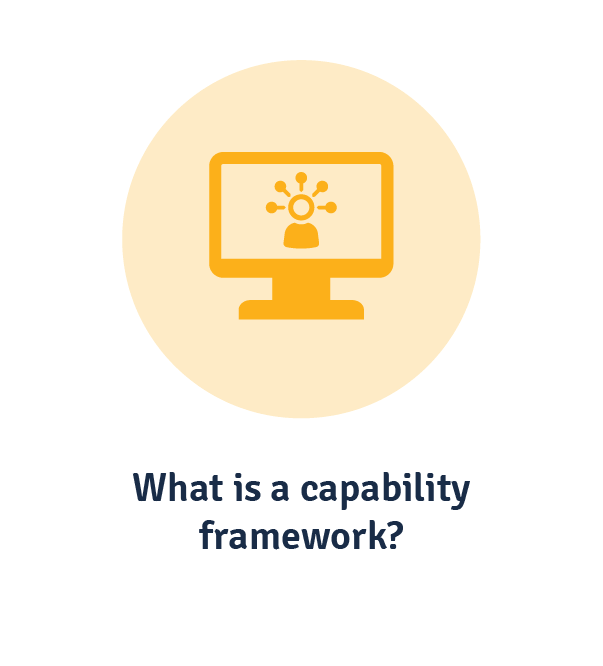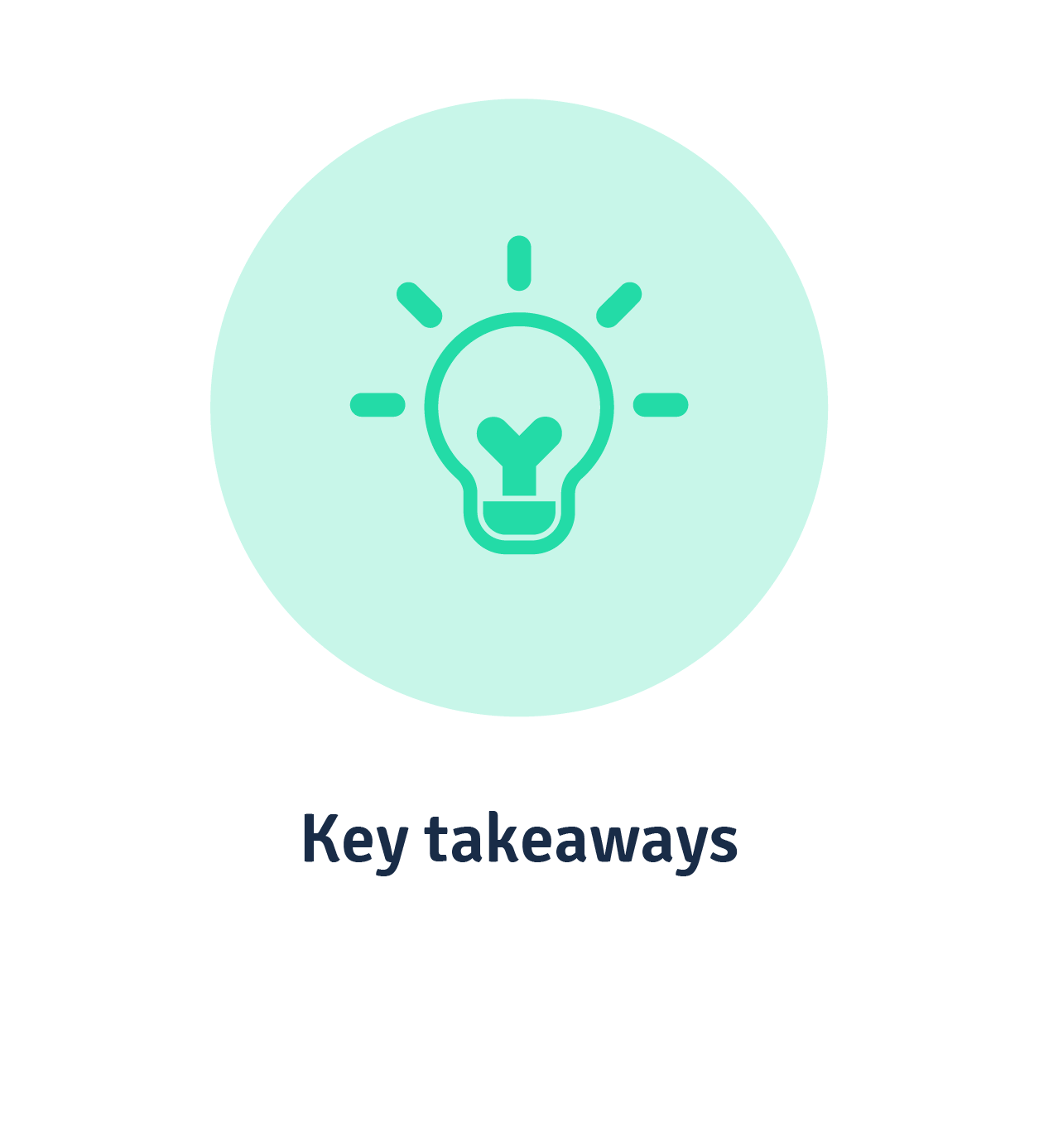Employee development needs, well, some development. A traditional skills-based approach isn’t moving the needle anymore (if it ever was). Enter: the capability framework.
A capability framework outlines the skills, knowledge, behaviours, tools, and processes needed for employees to achieve business goals, essentially linking business objectives with personal performance. It’s the nexus of all your workforce planning activities. Think: Role design, performance management, recruitment, and professional development. And most crucially, it’s what defines your ability to grow and succeed.
Let’s dive into everything you need to know about capability frameworks, from the structure and how to utilise it in the workplace all the way to getting a better ROI on your L&D efforts.
What is a capability framework?
A capability framework outlines the skills, behaviours, knowledge, tools, and processes required for an organisation to achieve its goals. Capabilities are usually mapped to job roles and job families to define what is fundamentally important for an employee to be successful in their role. In this way, capability frameworks can be used to recruit, manage performance and create internal mobility.
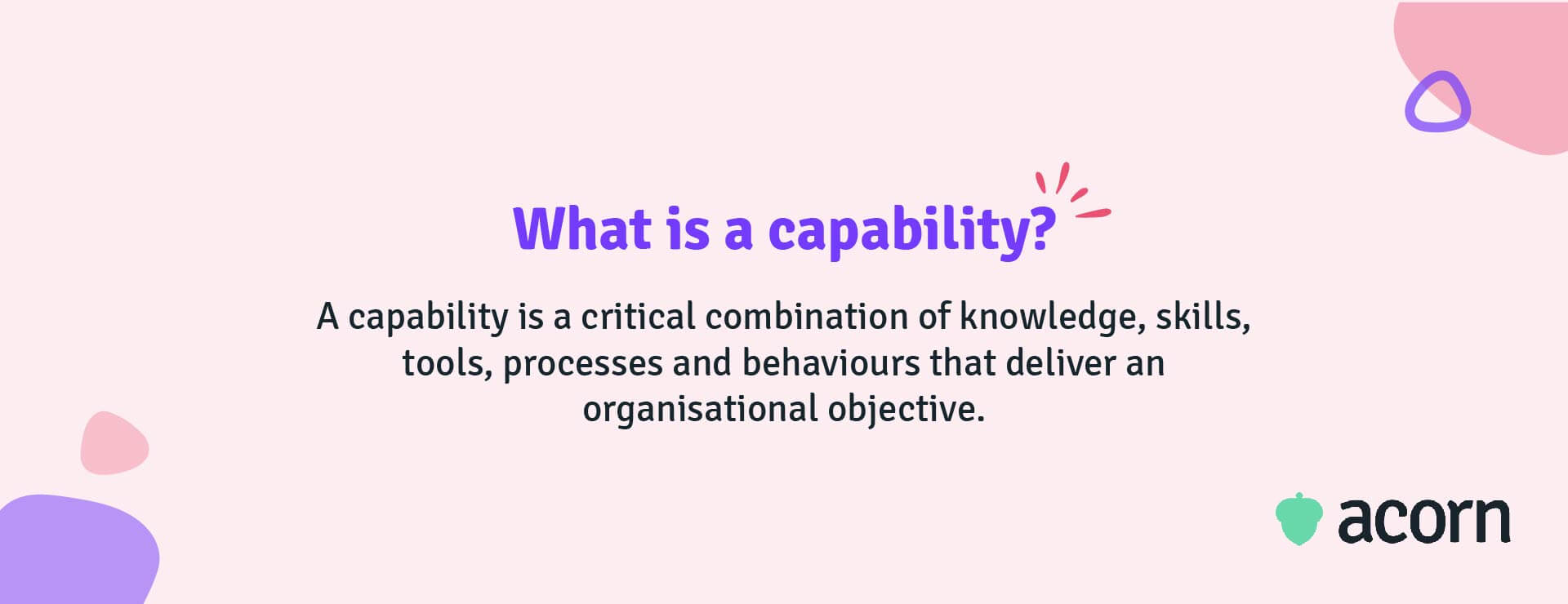
Why are capability frameworks important to human resources?
Capabilities, though organised into levels of proficiency based on job roles and their corresponding business responsibilities, are considered critical at any level to achieving business success. In other terms, capabilities define what a business does in order to fulfil its mission.
A capability framework describes those capabilities, and associated expectations of proficiency, in a way all employees can understand. For example: the NSW Public Sector Capability Framework lists Manage Self as a capability. Across several grades of proficiency, this is described as:
- Prioritising one’s task load
- Evaluating your own performance & seeking feedback
- Seeking development opportunities
- Managing emotions
- Taking initiative
- Utilising negative feedback for growth
- Acting as a role model for colleagues
- Promoting the value of self-improvement
- Keeping up to date with current practices.
Your capabilities will and should change as your company grows and your goals evolve. The roles needed in a tech start-up will be more niche than a global software company. And the roles that tech start-up needs when they’re past their growth stage will be vastly different and more varied than the first time they ever recruit.
Then there’s the employee experience to consider. How can they truly be sure they’re effectively performing their roles, embodying business values, and working well with others? Are they certain of the skills and knowledge needed to progress in their careers? How can team leaders accurately measure and manage performance? All of which leads to one more question.
So, just why is a capability framework so important to organisational success?
By defining the skills, knowledge and behaviours needed for effective performance at all levels in your company, you create a universal language that’s accessible for everyone in the business. A capability framework also crucially establishes how each role relates to organisational outcomes.
Clear expectations for both success and the personnel life cycle is what drives proper workforce planning. It also enables your HR team to effectively align their work with strategic business goals, as well as more clearly communicate across departments.
The 12 key benefits of a capability framework
Implementing a capability framework enables your organisation to:
- Recruit talent more effectively through job and role design
- Maintain an adequate talent supply now and into the future
- Better evaluate performance and manage talent
- Identify and close capability gaps more efficiently
- Provide more personalised professional development—and prove their impact
- Improve the quality of services or products and customer or client relations
- Act on strategic succession and workforce plans
- See clear progression from level to level
- Enact change management processes
- Stay clear on how to successfully complete daily tasks
- Understand and unlock leadership potential
- Create career pathways across teams and departments.
So, yeah, not exactly small change.
The structure of workforce capability frameworks
In short, a capability framework has a few defining features. It:
- Balances technical and soft skills
- Defines ascending proficiency levels
- Is entirely unique to your organisation.
The long of it is how capabilities are created. Where skills are often transferable across organisations, capabilities and capability frameworks are always contextually unique to your company. They’re not tied to one team or process, either. Your capabilities are cross-functional. It can be tempting to look at a framework and search for “your part”, because the schematics can look very much like an organisational hierarchy.
Remember: Capabilities are defined in business terms. Each defines what it does for the business. If you would change a capability to “suit” different departments or every time you implement a new system involved in delivery on that capability, it’s not an organisational capability.
With that in mind, a capability framework is generally presented in groups or categories first, hierarchy second. At the highest level of a framework, you’ll have a select suite of focus capabilities. From there, you can categorise capabilities by job role or function. Think marketing or sales: basically, you’re grouping capabilities by the technical requirements of a field, department or function.
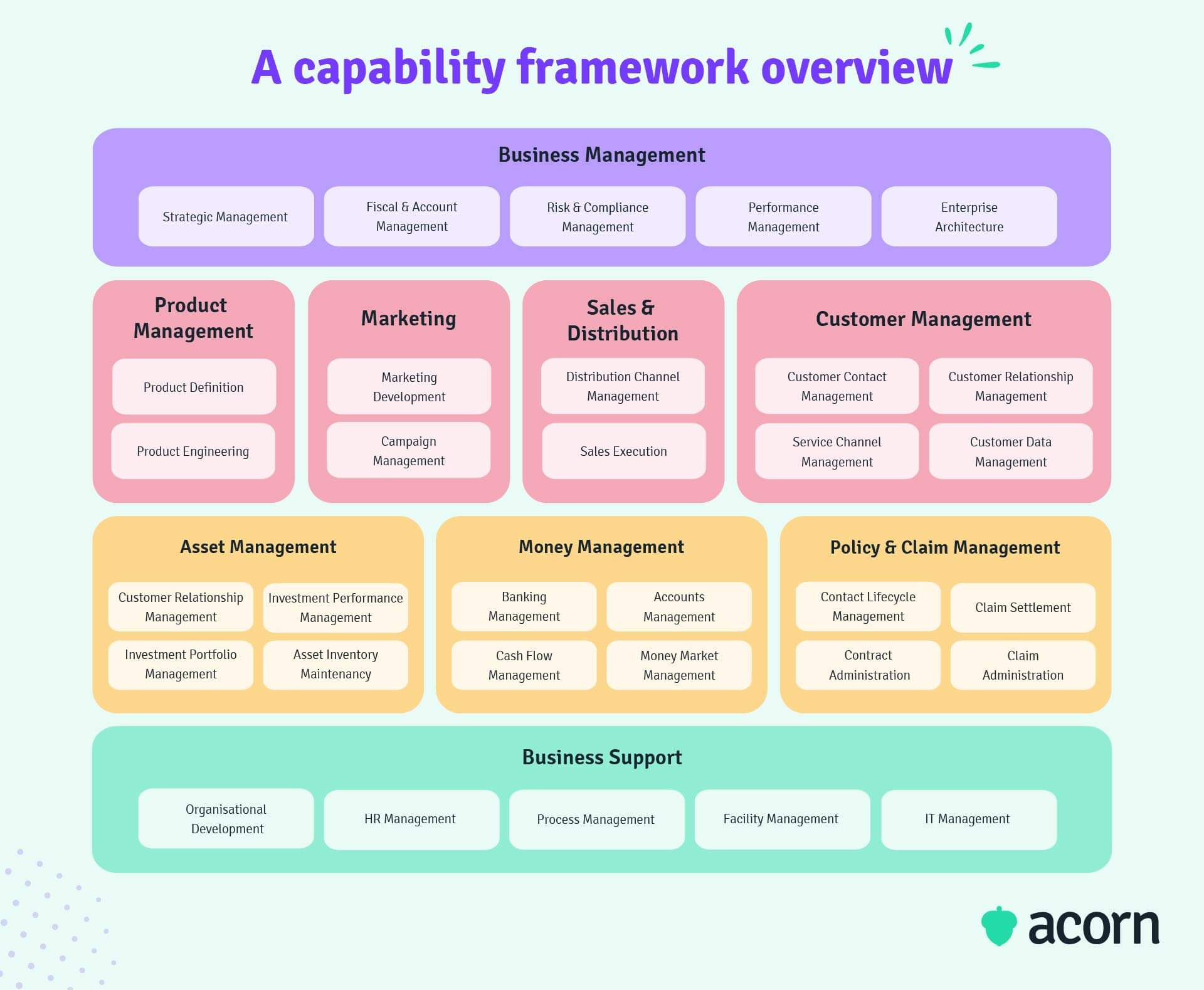
Capabilities are then distilled by levels of proficiency or competency. These levels define a standard of performance expected at a certain level of employment (i.e., entry level all the way through to C-Suite). Competency levels can be attached directly to job roles, or they may simply be described as beginner, intermediate, and advanced.
Think of it as a scale or spectrum. It isn’t a matter of being capable or not capable, or possessing or not possessing a skill, but rather increasing capacity to perform progressively more complex tasks.
What are focus capabilities?
Focus (or core) capabilities are the main groupings of capabilities within a framework. These are the highest level of knowledge, skills, and behaviours employees must possess to effectively perform in their roles, and are intrinsic to your company not only thriving, but existing.
Think of them as your main food groups. You need a balanced variety of vegetables, fruits, grains, dairy and protein to survive. No one group is more important than the other, nor would you suggest that any of your friends only focus on a single group for optimal health. Rather, each bring offers its own value to your personal goals.
Examples of focus capabilities include:
- Results / outcomes
- People management
- Personal attributes
- Standardisation
- Strategy
- Leadership
- Relationships
These are all broader drivers of business success, and in practice, often encompass business values and goals. Unilever lists Product Management as a focus capability because it is core to their business. This is part of what Unilever does. McDonald’s has Community as one, which aligns with their charitable contributions like Ronald McDonald House. These examples are both unique to the companies’ abilities and services, and part of their competitive advantage.
So, essentially, if you can identify what your business can do better than anyone else, then you should codify that.
Focus capabilities don’t need to be segmented by departments or job families. Think of them as reinforcing activities. If you want more information, a good example comes from NSW Government. Their Public Sector Capability Framework has three core capability groups that apply to all job roles and two that are applicable only to managers, for a total of five focus capabilities.
TL;DR: Focus capabilities are generally meant to be viewed contextually together to gain a more comprehensive picture of what is expected for employees.
How to apply a workforce capability framework
First and foremost: Without a capability framework, you could fall into the trap of ad hoc learning and development. This is akin to throwing uncooked pasta at the wall and hoping it sticks. There may be a chance that for some employees, unscheduled L&D comes at the right time. But for the collective—and your organisation—this is one big waste of pasta… ahem, money.
Let’s look to the public sector for some examples. The NSW Government use theirs for everything from writing job descriptions to promoting mobility. ASIO’s (that’s the Australian Security Intelligence Organisation) outlines what is needed to deliver against their purpose (access by clicking here). The National Disability Insurance Scheme says their capability framework provides a common language to describe “what good looks like” (access here) for those who use their services.
Well-managed L&D can (and should) deliver the right people with the right skills at the right time, now and into the future. This is a key part of strategic WFP, making a capability framework as much a guide for managing L&D as it is for business success. In fact, it can guide you on three fronts:
- Aligning learning and business outcomes
- Supporting learning in the flow of work
- Evaluating learning effectiveness.
Align learning with business outcomes
Your capability framework should link employees’ personal goals with business objectives. One of L&D’s primary functions is to develop people in a way that supports key business priorities an ongoing basis. Sounds easy enough, no?
L&D history generally states that most corporate learning initiatives struggle to show impact. So, we start at impact.
What are the strategic objectives of your organisation? Familiarise yourself with what your business is trying to achieve in the next one, two, five, 10 years? You can only develop the capabilities you need if you know exactly what knowledge, skills, behaviours, tools and processes are necessary to drive those.
From there, you’ll then want to identify the gaps between your existing capabilities and those you’ll need in future. Gap analyses and assessments lay the groundwork for development and learning plans, as well as giving insight into the capabilities your organisation has available right now. Think of that like pulling levers in a machine; capability assessments essentially tell you which ones are functioning perfectly and which are rusty, and therefore slowing your machine down.
Don’t forget to consider environmental factors at this stage. Fast-moving industry changes, particularly technological, often dictate in-demand skills. Economic uncertainty changes the job market and availability of external talent (all the more reason to have a solid capability framework and plan to develop internally). CEOs will put emphasis on certain directives, and therefore, change the urgency for certain capabilities. Younger generations want professional development, and they’re not afraid to job hop to find it.
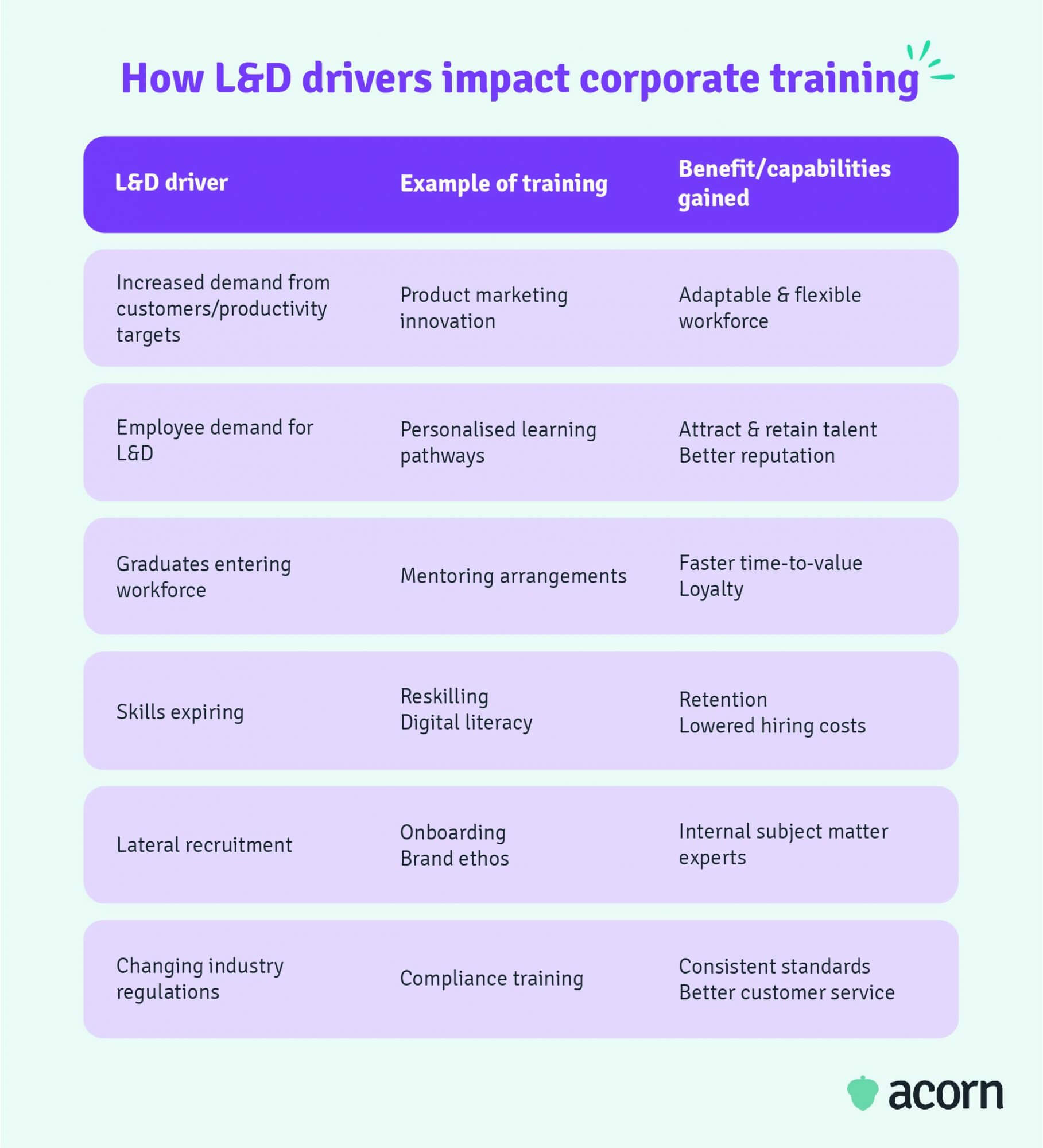
Support on-the-job performance
90% of learned knowledge is forgotten within a week. Doesn’t bode well for crucial capability building.
Most often this is because learning is not reinforced post-training, or even designed to be accessed in the flow of work. By that, we mean it’s not providing solutions to pain points as they occur. By using L&D as an everyday tool—like a self-service FAQ, rather than a monthly or quarterly compliance check—employees can reinforce and build capabilities as they work.
The whole point is to build capabilities for performance, after all. If you’re hiring on perceived potential, it becomes more even crucial to help employees learn business-critical capabilities as fast as possible.
Experiential learning is a safe way to introduce developing capabilities into the workplace, because it:
- Mitigates the forgetting curve through real-time reinforcement
- Increases employee engagement through active and social learning
- Is contextually relevant for the learner and their role
- Encourages agility with real repercussions to mistakes and rewards for innovation.
It’s not just about microlearning. You should treat your learning solution as the knowledge repository for your organisation. Learning content mapped to each of your organisational capabilities enables you to do this. (Be wary of systems that push content before context; you want to be able to guide learners through relevant learning opportunities, not force them to find their own training.)
The added benefit here is consistent iteration of business performance. If your workforce is always building capability (as outlined in your framework), then your organisation is always moving forward.
Evaluate learning effectiveness
You may have found yourself up against lack of supporting data and performance measures when trying to determine learning efficacy. When you factor in capability frameworks, it then becomes a question of whether learning is effectively targeting the capabilities you need to achieve business goals.
Remember those proficiency levels? They can be mapped to learning outcomes. This helps you identify what course addresses which learning outcome, and gives you a measure of effectiveness. As an example:
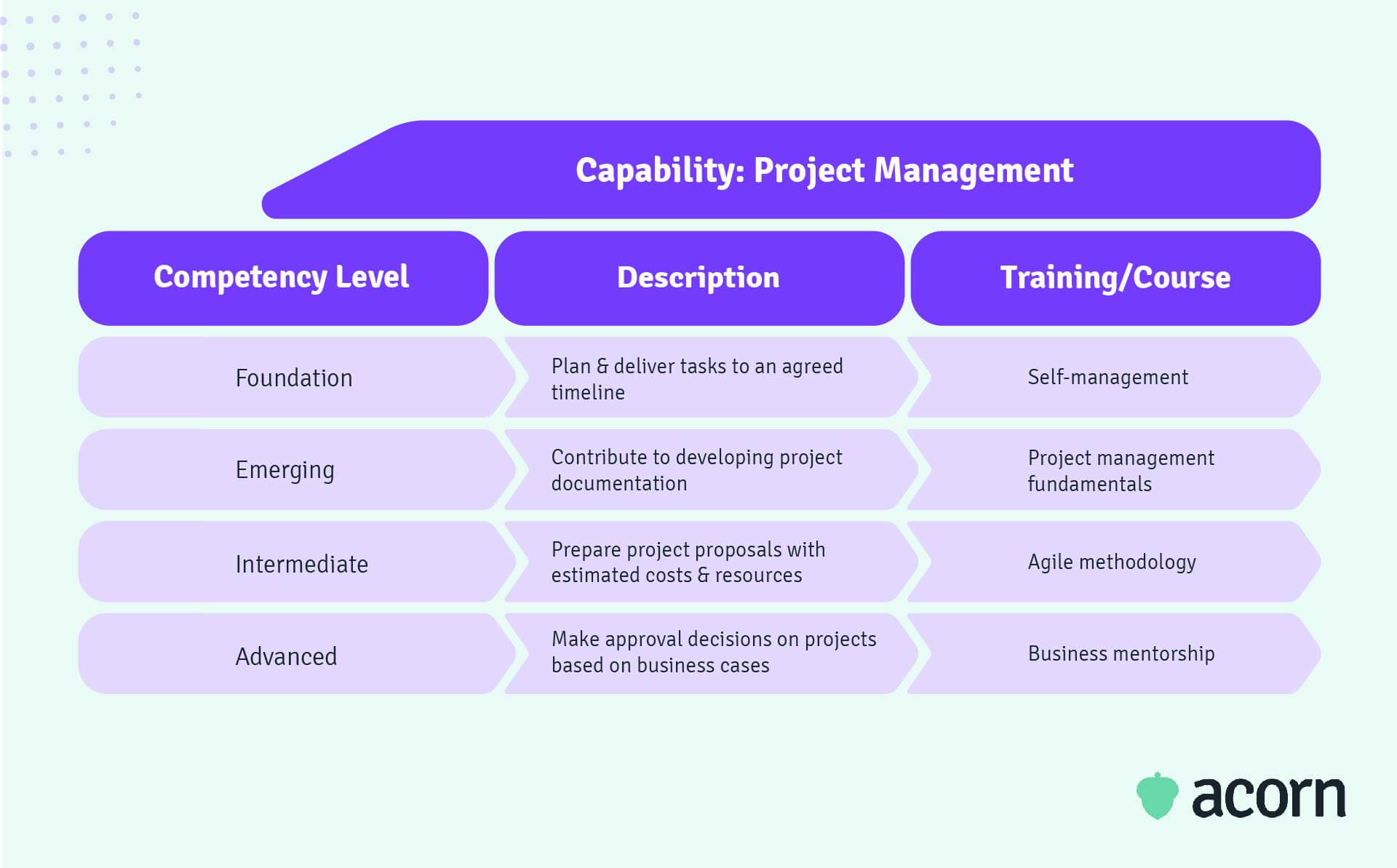
If you’re using a learning solution like a PLMS (performance learning management system), you can map learning content directly to competency levels, not just capabilities. Let’s say an employee, Joel, does a capability assessment and is evaluated at the foundational level of competency for the capability Change Management, of which his job role requires him to be working at an advanced level. Within our PLMS Acorn, Joel would be immediately assigned content mapped to the intermediate level of Change Management.
Not only does this make it easier to track development for individuals, but it enables you to narrow in on the exact level of competency they’re performing to. You’ll get more bang for your learning completions buck when it comes time to prove L&D ROI, given competency levels can act as a measure of time to proficiency and can be linked directly to on-the-job performance.
In this way, not only are you ensuring that you are providing employees with the appropriate level of challenge, but you can ensure a program is actually targeting the capabilities you need.
How managers can use capability frameworks
Capabilities may seem like a C-Suite or HR practice—but a framework is an incredibly useful tool for managers in their day-to-day.
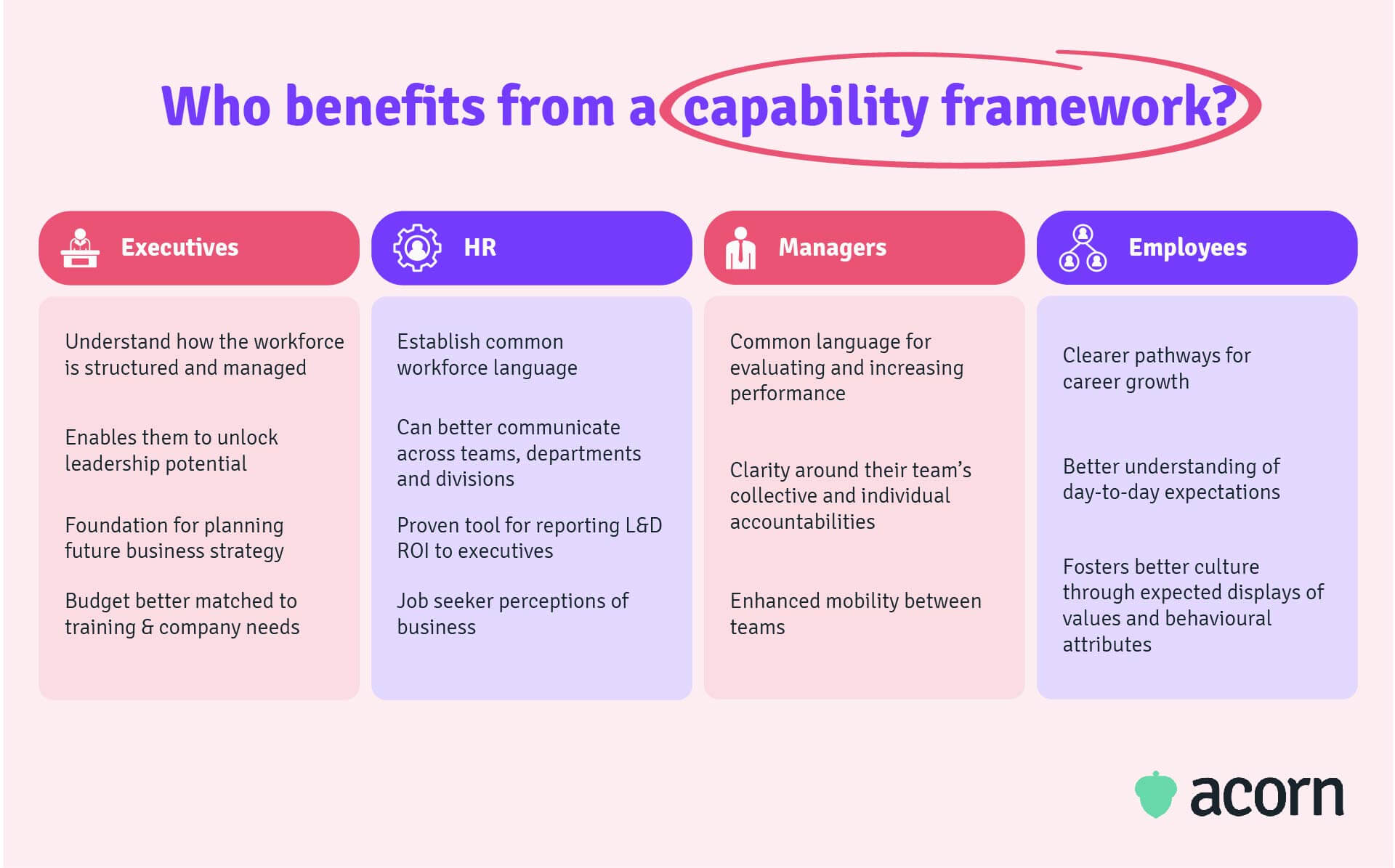
Managing a team’s performance is an intricate and often time-consuming process. Ergo, a framework can help streamline:
- Job descriptions
- Recruitment and development
- Performance management.
Job role descriptions
The art of writing job descriptions is one few can master. It’s the first tone-setter for potential recruits, so it’s important not to misstate the knowledge, skills, and behaviours required for a role. It’s also often a point of reference for managing performance evaluations.
Good job design will derive from capability frameworks. All roles should encapsulate a collection of capabilities, either occupation-specific or otherwise. Depending on your competency descriptors, you may even assign certain levels of competency to a role. This works best in larger organisations, who are likely to have a greater number of job families and roles within those families.
Recruitment
You can also use those job descriptions for smarter recruitment. Capabilities give you an accurate baseline to gauge potential, and if you add in any recruitment assessments, you can attach them to competency levels to also understand the development needs of new hires.
But the real kicker is how you can recruit internally. When mapped within your learning or HRIS system, your capability framework transforms into a living, breathing register of the talent you have in your organisation. Will capabilities need to be developed to fit this role? If so, what development pathways are most efficient? Hiring internally means new “hires” already know your organisation’s culture and performance expectations—lowering time to proficiency on the job and the time it takes to fill vacant roles.
Performance management
Effective performance management is not just about evaluating output. Managers need to be able to identify and nurture talent, making it both a crucial capability in your leaders and a lynchpin for employee development.
And, you guessed it, the capability framework again comes in handy for performance management, not least of all because it’s universally understood.
- At the highest level, it provides clear metrics for evaluating performance.
- When discussing career planning and progression, managers have a solid pathway they can show to an employee.
- In the scenario in which someone is “underperforming”, a framework can help managers determine if the problem lies with the employee not understanding expectations, if the role doesn’t fit their current capabilities, or if it’s behavioural (i.e. low motivation or engagement).
- It’s an opportunity to examine what is and isn’t working for an employee in their role or learning plans. That’s also an easy way to help employees commit to development and begin to self-evaluate.
- It’s also a chance to exemplify future-focused behaviours as a leader—aka forward thinking, problem solving, and opportunity identification.
- When comparing notes with other people managers, it allows for potential job shadowing and knowledge sharing.
How employees can use a capability framework
Again, a capability framework is not something to be shrouded in C-Suite mystery. A sustainable and successful business relies on employees knowing what they need to do and when they need to do it.
A capability framework shows capabilities in simple terms for employees. Better yet, a capability framework within your LMS (or PLMS) shows capabilities in terms of career development.
Important, when you consider a large portion of the workforce does not feel prepared for the future of work, predominantly because they feel they lack the right capabilities. A workforce that not only lacks the technical skills, knowledge and behaviours, but also confidence required to perform effectively will hamper business growth, potentially increase turnover, and effect your employer brand.
Position your capability framework as a guide for employees. Through job descriptions and learning plans, capabilities can create a guided path to job mastery. The right support systems (again, we defer to the PLMS) will also give employees the ability to choose additional capabilities they’re interested in developing, which has two distinct benefits.
First, interest capabilities help pique learner engagement while, second, developing capabilities that are still key to business objectives and organisational capability building. Think: a marketer taking a sales module, or a designer running through a communications course.
On the other end, traditional performance reviews involved the manager telling the employee about their work output. This removes a key player from the process: the employee.
A capability-led performance strategy wants employees to be more involved in their own development. It’s why Acorn PLMS includes self-evaluations as part of the capability assessment feature. While some subjective bias can still exist with assessing one’s own performance, the baseline metrics are objective across the board. Acorn also produces a visual report of the gap between current and required capability, and offers manager and subject matter expert evaluations for a well-rounded evaluation.
The key advantage is giving employees insight into their performance. Alongside historical learning and capability data, they’re able to advocate for themselves, understand areas for improvement, and seek out resources to plug gaps, all from the one platform.
Key takeaways
The strategic importance of a capability framework cannot be understated. It defines the skills, knowledge, behaviours, tools, and processes needed to achieve organisational goals in a universal language that all employees—from C-Suite to new grads to contractors—can understand and utilise.
It’s crucial to:
- Provide impactful performance management
- Effectively track development
- Create strategic workforce plans
- Prove ROI of learning and development
- Sustain agility and internal mobility.
Key to adoption is making your capability framework readily available. A central knowledge system like a PLMS places capabilities at the heart of your learning and performance engine. Not only does this automate much of the learning and development process, it guides employees to develop the capabilities that will accelerate their own and your organisation’s performance.
Related Reads on This Topic

A Necessarily Deep Dive into Public Sector Capability Frameworks
There’s a lot private business can learn from how the global public sector create, use and revise their frameworks.

How High-Impacts Orgs Use an L&D Maturity Model
Think of it like creating a why, how, what, who and when for impactful L&D.

The How-To Guide to Post-Training Enablement
Post-training enablement is just important, if not more important than training itself.
